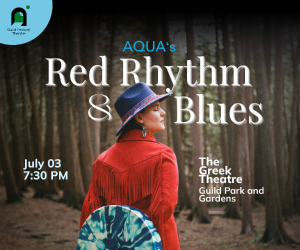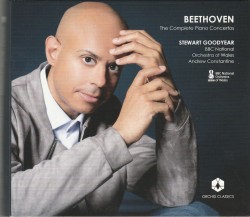 Beethoven – The Complete Piano Concertos
Beethoven – The Complete Piano Concertos
Stewart Goodyear; BBC National Orchestra of Wales; Andrew Constantine
Orchid Classics ORC100127 (naxosdirect.com)
Fond of storytelling, the dauntless Stewart Goodyear has long been associated with Ludwig van Beethoven, preferring a cyclic approach to the composer’s catalogue. Dubbed “The New Testament” of keyboard literature, Beethoven’s 32 sonatas have frequently been performed by Goodyear in a single day; he has also recorded the full cycle.
Now, a recent release from Orchid Classics features yet another testament: the five piano concertos, spanning three full discs, in chronological order. In the opening essay of the liner notes, Goodyear recounts his first meeting with the concerti, at age nine: “…great theatre, great drama, great virtuosity, and most importantly, great merriment. I felt like I was hearing Beethoven the entertainer, the actor, the storyteller, the playwright.”
Goodyear’s considerable success at performing the complete cycle of sonatas has led him to this point: the concertos. He continues to probe the multifaceted nature of Beethoven’s craft – as he’s outlined in the observation above. With evolving depth of knowledge and stylistic insight, Goodyear celebrates these cornerstones of the concerto catalogue, aiming for a kind of narrative arc, from the youthful first, Op.15 to the fifth, Op.73, the “Emperor.” Choice of orchestral collaborator for this ambitious project has been apt: Andrew Constantine and the BBC National Orchestra of Wales coexist with Goodyear’s musical vision, offering an attractive kind of vigour and dedication.
Like the impressive lineage of Beethoven exponents before him, Goodyear retains a pianistic perspective that is invariably clear and pronounced. If anything, he seems galvanized by the past achievements of great artists who have recorded this repertoire – Alfred Brendel, Wilhelm Kempff and Artur Schnabel, to name but a few: mighty company indeed!
Adding various touches of his own, Goodyear experiments with early Romantic rubato, often shaping musical lines in unusual ways. His choice of tempi can tend toward surprise, as he takes characterful liberties and rests, seldom ventured by others. He does prove master of quicksilver textural changes; at best, these sharp turns offer rushes of excitement, steering the listener headlong from one structural pillar to the next, leaping – bounding – along the way. The manner is particularly effective in cadenzas and freer passages which are delivered with the utmost control and technical tang.
Goodyear’s approach is consistently individual, finding niches to exploit for his own particular brand of music-making. Sometimes, the curious ebbs and flows of inflection betray unusual rhythmic pacing. Nevertheless, within such melodic curves, microstructures of motivic design are revealed – that very well might be Goodyear’s intention! Omnipresent is a low-fi, headlong sense of chase: a playful, almost childlike glee detected in much of the fast, rhythmic material, particularly in the early concertos, Nos.1 and 2.
There are moments of tenderness and cajoling here that tug at our hearts – a side of Beethoven one should hardly forget about. As faithful soloist, Goodyear opens up to us with valiant vulnerability. As per his own claim, this “vulnerability” is a quality learned from Beethoven’s 32 sonatas and apparently, one he continues to enshrine.
Adam Sherkin
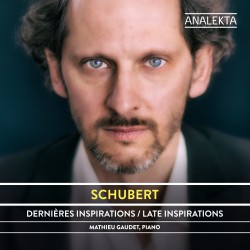 Schubert – Late Inspirations
Schubert – Late Inspirations
Mathieu Gaudet
Analekta AN 2 9182 (analekta.com)
Mathieu Gaudet has recently embarked on a Schubert project, presenting the lion’s share of the composer’s works for keyboard. While themed Late Inspirations, the latest disc (Volume 2) opens with an early sonata, followed by two other works: the curious Ungarische Melodie, D817 and the Drei Klavierstücke, D946.
Gaudet’s artistry is quintessentially suited to Schubert: it possesses a tender, inward nature that, while personal, is never furtive; Gaudet consistently cherishes every miraculous musical turn, sharing them generously with his listener (and even ornamenting certain melodies and harmonies along the way!). The music of Schubert – clearly a lifelong vocation for Gaudet – seems the perfect platform for his aptly controlled, cultivated musicianship. When it comes to the Austrian master, sung indelibly from Gaudet’s piano, we are at once nourished and enlightened.
The five-movement Sonata in E major is rarely played. In the hands of Gaudet, this surprising – even quirky – piece glistens and bubbles with a delightful lack of self-consciousness, justly suited to such early essays in the form. (Schubert wrote the sonata when he was 19.) Gaudet introduces this music to us like an old friend he’s been hobnobbing with for decades. One meets wondrous things: humour, juvenility and even a bit of Viennese buffoonery – a notable feat of Schubertian interpretation!
Perhaps it is worthy to note in these trying times of the COVID-19 pandemic that Gaudet is also a full-time emergency physician. We eagerly await the future instalments of his recording project once the current crisis has abated. Our world will need more Schubert like this.
Adam Sherkin
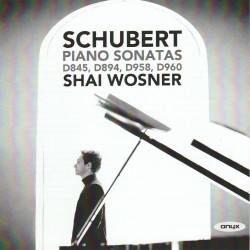 Schubert – Piano Sonatas D845; D894; D958; D960
Schubert – Piano Sonatas D845; D894; D958; D960
Shai Wosner
Onyx ONYX 4217 (shaiwosner.com)
While Schubert succeeded in publishing only three piano sonatas during his lifetime, the depth of his world is fully revealed in this genre, especially in the late sonatas presented on this album. Shai Wosner, considered to be one of the most prominent Schubert interpreters, is so intimately connected to that world that he becomes a guide of sorts, leaving no corners of Schubert’s musical mind untouched. A beautiful essay Wosner wrote in the liner notes for this album brings these intimate explorations to the next level.
In contrast to the preceding period of songwriting, Schubert’s late piano sonatas opened up a different microcosm, putting on full display the unique ingredients of his musical mode – the uncanny combination of intimate gestures in a large setting. Four sonatas on this album show different aspects of that mode – dark, melancholy momentum in Sonata No.16 in A Minor, transparent stillness in Sonata No.18 in G Major, relentless fire in Sonata No.19 in C Minor, and yearning introspection in his last major work, Sonata No.21 in B-flat Major. All four seek to deconstruct the conventional sonata structure and do it with the vulnerability of distinct musical expressions.
I love Wosner’s sound, the manipulation of colours and his control over the smallest of details. Equally convincing in lyrical language as he is in bold, fiery passages, Wosner brings in wholesome devotion to this remarkable music.
Ivana Popovic
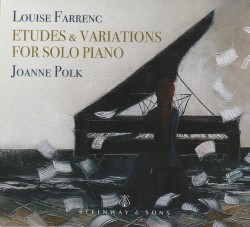 Louise Farrenc – Etudes & Variations for Solo Piano
Louise Farrenc – Etudes & Variations for Solo Piano
Joanne Polk
Steinway & Sons 30133 (naxosdirect.com)
The name Louise Farrenc is practically unknown today, but during her lifetime, she was a respected composer and pedagogue at a time when the professional artistic world was very much male dominated. Born in Paris in 1804, she was an almost exact contemporary of the novelist George Sand. Like Sand – and also Clara Schumann and Fanny Mendelssohn – she was forced to overcome societal biases of the time, but ultimately enjoyed a long and successful career. Her compositions include symphonies, overtures, chamber, choral and vocal music, and a great many pieces for solo piano. These latter are well represented on this Steinway & Sons recording featuring American pianist Joanne Polk.
The first three tracks on the disc are sets of variations; the first on a Russian song; the second on an aria from Bellini’s Norma; and the third, the Lutheran chorale Ein Feste Burg used in Meyerbeer’s successful opera Les Huguenots. The music is elegant and well crafted, with the original themes creatively varied. Throughout, Polk demonstrates a real affinity for the music, approaching it with considerable fluidity and élan.
The two sets of Etudes Op.26 making up the remainder of the disc were so highly regarded that they were ultimately adopted by the Conservatoire as required repertoire. There is much to appreciate in these musical gems – do I hear echoes of Mendelssohn and even Chopin? Many of them pose considerable technical challenges that surely only advanced pupils could have handled.
Despite its obscurity, Farrenc’s music should never be dismissed as secondary. There is evidence of fine creativity, matched here by an equally fine performance. Kudos to Joanne Polk and to Steinway & Sons for helping bring to light repertoire that might otherwise have been overlooked. Recommended.
Richard Haskell
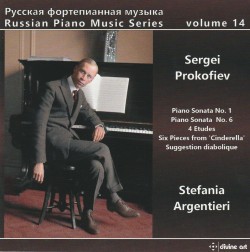 Russian Piano Music Series Vol.14 – Sergei Prokofiev
Russian Piano Music Series Vol.14 – Sergei Prokofiev
Stefania Argentieri
Divine Art dda 25156 (divineartrecords.com)
Prokofiev began his career as a concert pianist; hence it comes as no surprise that piano music comprises a significant part of his output – three concertos, nine sonatas and more than 100 pieces of various types written over a 40-year period. His continual quest for freedom from typical 19th-century styles resulted in a particular eclecticism, clearly evident in this attractive program on the Divine Classics label, performed by Italian pianist Stefania Argentieri.
This disc is the second in the Russian Piano Music series devoted to Prokofiev and includes his first and sixth sonatas, Six Pieces from Cinderella Op.102, Four Etudes Op.2 and the Suggestion Diabolique.
The Piano Sonata No.1 from 1907 – but later revised – owes more than a passing reference not only to Schumann, but also to Rachmaninoff and Scriabin, the style lushly Romantic. In contrast, the sixth sonata, written in 1940, is pure pianistic gymnastics, technically beyond the capabilities of many pianists. Here, Argentieri demonstrates a true command of this daunting repertoire, meeting the challenges with apparent ease. Equally demanding are the Four Etudes, music of a confident 18-year-old pianist/composer eager to demonstrate his skills. The set was originally intended as a “slap in the face” to conservative audiences, but it also earned him a loyal following.
Cinderella is one of Prokofiev’s most popular ballets and while the set of piano transcriptions from 1944 is equally delightful, it’s the youthful Suggestion Diabolique where Argentieri once again proves her pianistic prowess. Aptly marked Prestissimo Fantastico, the piece demands extraordinary virtuosity – a true perpetuum mobile, with a surprisingly calm conclusion that brings the disc to a subdued, but most satisfying conclusion.
Richard Haskell
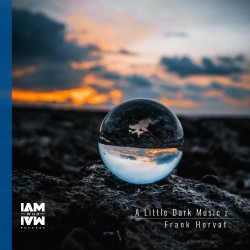 A Little Dark Music 2
A Little Dark Music 2
Frank Horvat
IAM who IAM Records (frankhorvat.com)
Toronto composer and pianist Frank Horvat’s passionate concern for social and environmental issues has long been a core theme in his music. His 2010 album, A Little Dark Music, for example, featured Earth Hour, an hour-long solo piano improvisation performed in the dark. In it, the composer-pianist passionately advocated for a sustainable approach to the environment. A decade later, Horvat’s follow-up solo grand piano release, A Little Dark Music 2, his 11th album, continues to expresses his extra-musical concerns for the health of our planet.
The title theme of the opening hour-long track Earth Hour 2 is confirmed by the explicit program notes. Horvat renders a personal commentary on the state of our global environment in this expansive solo. The liner notes suggest we take the time “to become grounded within [ourselves]” to reflect on positive change we can imagine while we listen. And the episodic and programmatic nature of this explicitly tonal work leaves plenty of time and sonic space for contemplation
The much shorter Heat Island continues the theme of man-made climate change. “The rumbly and murky start of this composition attempts to emulate the world oozing heat from pavement,” states the composer. As the piece progresses, “it gradually works its way up to the higher registers with a more calm tone.”
The album concludes with the optimistic Life for Mars, a (mostly) major key “soothing statement on the positive impact of connecting to ourselves and our surroundings.” It’s a message of hope many of us can use during this dark time.
Andrew Timar
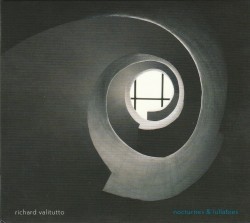 nocturne & lullabies
nocturne & lullabies
Richard Valitutto
New Focus Recordings FCR243 (newfocusrecordings.com)
Contemporary keyboard exponent Richard Valitutto has released a timely, meditative new record that features seven premiere recordings of works by six composers. (The penultimate track on the album – Linda Catlin Smith's A Nocturne – was first recorded by Eve Egoyan in 2012.) each written within the last 35 years. Valitutto claims to have been “focused on cultivating a sort of pianistic ‘anti-virtuosity’... performing music that seems simple on the surface but in actuality affords a great many challenges.” The tracks are, generally, connected to the theme of night and its various dimensions: dream-haunting nocturnes and lullabies, uncertain of – or anachronistic in - their 21st century functions.
Admirable ranges of expression are displayed here through experimental modes of resonance. The disc’s chronology is well curated, moving through dark soundscapes to brighter moments of lucidity and repose. Immediately striking is Valitutto’s intimacy with each of these works, collected and considered from a specific time and place with fortitude and explorative zeal.
Amongst the many highlights of the disc is shadow (2013) by Rebecca Saunders, a study in so-called “acoustic shadows.” Valitutto relishes this music’s intensity and sculpture, urging a keen ear when listening to every last brilliant moment of the score.
Another intriguing track is Philip Cashian’s Nocturne (1984). Modelled on Oliver Knussen’s Sonya’s Lullaby, Cashian’s newer piece supersedes Knussen’s, grabbling its way to overcome all aches and sighs. Now morbid and jazzy, now contemporary and timeworn, this entire album grips both performer and listener alike, glimpsing a hazy yet urgent future where nocturnes and lullabies still haunt our dreams.
Adam Sherkin



